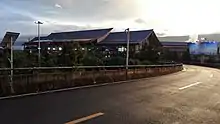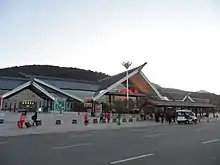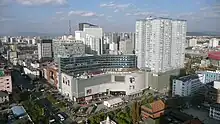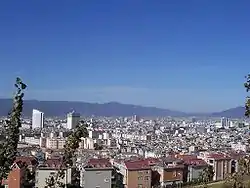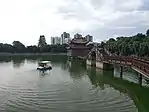Lijiang
丽江市 Likiang | |
|---|---|
 | |
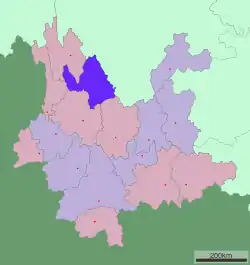 Location of Lijiang City jurisdiction in Yunnan | |
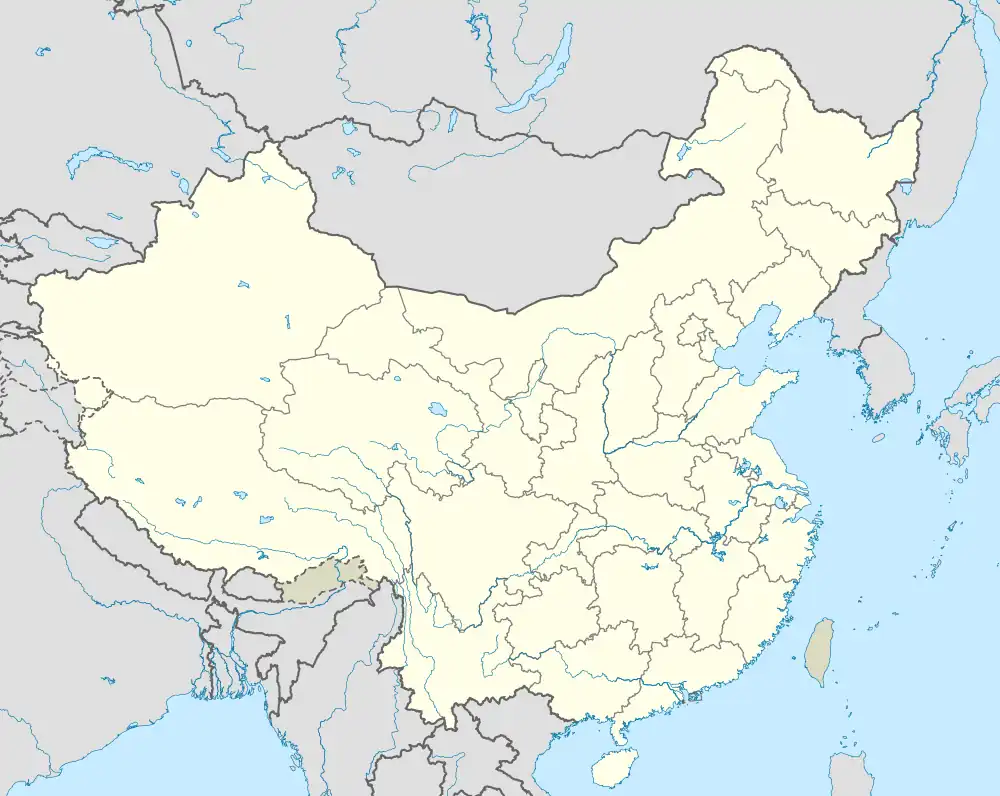 Lijiang Location in China | |
| Coordinates (Lijiang municipal government): 26°51′19″N 100°13′33″E / 26.8552°N 100.2259°E | |
| Country | People's Republic of China |
| Province | Yunnan |
| Admin HQ | Gucheng |
| Area | |
| • Prefecture-level city | 20,557 km2 (7,937 sq mi) |
| • Urban | 1,264 km2 (488 sq mi) |
| • Metro | 1,264 km2 (488 sq mi) |
| Elevation | 2,400 m (7,900 ft) |
| Population (2020 census)[1] | |
| • Prefecture-level city | 1,253,878 |
| • Density | 61/km2 (160/sq mi) |
| • Urban | 288,787 |
| • Urban density | 230/km2 (590/sq mi) |
| • Metro | 288,787 |
| • Metro density | 230/km2 (590/sq mi) |
| Time zone | UTC+08:00 (China Standard) |
| Postal code | 674100 |
| Area code | 0888 |
| ISO 3166 code | CN-YN-07 |
| Licence plate prefixes | 云P |
| Website | lijiang |
| Lijiang | |||||||||||||||||||||
|---|---|---|---|---|---|---|---|---|---|---|---|---|---|---|---|---|---|---|---|---|---|
.svg.png.webp) "Lijiang" in Simplified (top) and Traditional (bottom) Chinese characters | |||||||||||||||||||||
| Simplified Chinese | 丽江 | ||||||||||||||||||||
| Traditional Chinese | 麗江 | ||||||||||||||||||||
| |||||||||||||||||||||
Lijiang (Chinese: 丽江), formerly romanized as Likiang, is a prefecture-level city in the northwest of Yunnan Province, China. It has an area of 21,219 square kilometres (8,193 sq mi) and had a population of 1,253,878 at the 2020 census whom 288,787 lived in the built-up area (metro) made of Gucheng District. Lijiang is famous for its UNESCO Heritage Site, the Old Town of Lijiang, which contains a mixture of different historical architecture styles and a complex, ancient water-supply system.[2]
History
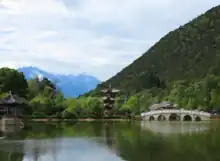
As far back as 100,000 years ago, people of the late Paleolithic were active in what is now Lijiang. The discovery of cave paintings in the Jinsha River Valley along with numerous neolithic stone tools and later artifacts of Bronze and Iron Age provenance prove Lijiang to have been one of the most important centres of ancient human activity in southwest China.
The Baisha Old Town was the political, commercial and cultural center for the local Naxi people and other ethnic groups for 450 years from the year 658 AD to 1107AD. The Dabaoji Palace of the Baisha Fresco, very close to the Baisha Naxi Hand-made Embroidery Institute, was built in the year 658 AD in the Tang dynasty (618 AD to 907 AD).
In ancient times, the Baisha Old Town used to be the center of silk embroidery in the southwest of China and the most important place of the Ancient Southern Silk Road, also called the Ancient Tea and Horse Road or Ancient tea route.[3] The Ancient Southern Silk Road started from Burma, crossed Lijiang, Shangri-La County, Tibet, continued through Iran, the Fertile Crescent before finally reaching the Mediterranean Sea.
The Kingdom of Lijiang submitted to Khubilai Khan as he led his troops against the Dali kingdom in 1253.[4] Though the kingdom was incorporated into the Mongol empire then the Yuan dynasty, it was given the status of tusi, or indigenous office, which gave autonomy to the local Naxi rulers. During the Ming dynasty, the Naxi were one of the few border peoples to support the Ming immediately.[4] As the Naxi helped the Ming expand in Southwest China the ruler family was given the title of Mu. During this period the Kingdom of Lijiang was able to expand into Sichuan and Tibet bringing many Tibetan peoples into its territory as well as their cultural and religious influence. [4]It was under the rule of the Naxi ruling house of the Mu family (木氏) during the Yuan (not yet named Mu), Ming, and Qing dynasties.[5] The Mu "held this position until 1723, when Lijiang became directly incorporated under the authority of the Qing central government."[4]
In 2002 Lijiang City was established, replacing the former Lijiang Naxi Autonomous County.
Geography and climate
Geography
.jpg.webp)
Lijiang is located in the northwestern portion of Yunnan and borders Sichuan. It is within the region encompassed by the Hengduan Mountains, where the Qinghai-Tibet Plateau and Yunnan-Guizhou Plateau converge. It borders Sichuan Liangshan Yi Autonomous Prefecture and Panzhihua City to the east, and Jianchuan, Heqing and Binchuan three of the Dali Bai Autonomous Prefecture in the south. County and Chuxiong Yi Autonomous Prefecture Dayao and Yongren counties, west and north are adjacent to Lanping County of Nujiang Yi Autonomous Prefecture and Weixi County of Diqing Tibetan Autonomous Prefecture. The city has a total area of 20,600 square kilometers and governs the ancient city, Yulong Naxi Autonomous County, Yongsheng County, Huaping County and Ninglang Yi Autonomous County.[6]
Climate
Owing to its low latitude and high elevation, the city centre of Lijiang experiences a mild subtropical highland climate (Köppen Cwb). Winters are mild and very dry and sunny (>70% possible sunshine), although average lows in December and January are just below the freezing mark; January, the coolest month, with 24-hour average temperature of 6.7 °C (44.1 °F). Spring begins early and remains dry and sunny until late May, when there is a dramatic uptick in frequency and amount of rainfall that lasts until late September. Summers are warm, rainy (more so than it is sunny) and damp, with June, the warmest month, averaging 19.1 °C (66.4 °F). Autumn sees an abrupt reduction in rainfall and return to sunniness. The annual mean temperature is 13.3 °C (55.9 °F), while precipitation averages 968 mm (38.1 in), around 80% of which occurs from June to September. With monthly percent possible sunshine ranging from 29% in July to 80% in December, the city receives 2,412 hours of bright sunshine annually.
| Climate data for Lijiang (1991–2020 normals, extremes 1971–2010) | |||||||||||||
|---|---|---|---|---|---|---|---|---|---|---|---|---|---|
| Month | Jan | Feb | Mar | Apr | May | Jun | Jul | Aug | Sep | Oct | Nov | Dec | Year |
| Record high °C (°F) | 22.6 (72.7) |
23.6 (74.5) |
26.3 (79.3) |
28.9 (84.0) |
30.8 (87.4) |
32.3 (90.1) |
31.4 (88.5) |
28.2 (82.8) |
28.7 (83.7) |
26.1 (79.0) |
23.6 (74.5) |
22.8 (73.0) |
32.3 (90.1) |
| Mean daily maximum °C (°F) | 14.1 (57.4) |
15.7 (60.3) |
18.0 (64.4) |
20.8 (69.4) |
23.1 (73.6) |
24.5 (76.1) |
23.4 (74.1) |
23.1 (73.6) |
21.8 (71.2) |
20.4 (68.7) |
17.4 (63.3) |
14.9 (58.8) |
19.8 (67.6) |
| Daily mean °C (°F) | 6.7 (44.1) |
8.7 (47.7) |
11.2 (52.2) |
14.2 (57.6) |
17.0 (62.6) |
19.1 (66.4) |
18.4 (65.1) |
17.8 (64.0) |
16.3 (61.3) |
13.7 (56.7) |
9.8 (49.6) |
7.0 (44.6) |
13.3 (56.0) |
| Mean daily minimum °C (°F) | 0.6 (33.1) |
3.1 (37.6) |
5.9 (42.6) |
9.0 (48.2) |
12.0 (53.6) |
14.9 (58.8) |
15.0 (59.0) |
14.3 (57.7) |
12.8 (55.0) |
9.0 (48.2) |
3.8 (38.8) |
0.5 (32.9) |
8.4 (47.1) |
| Record low °C (°F) | −7.0 (19.4) |
−6.0 (21.2) |
−4.0 (24.8) |
−1.3 (29.7) |
3.5 (38.3) |
6.2 (43.2) |
6.9 (44.4) |
6.6 (43.9) |
3.4 (38.1) |
0.9 (33.6) |
−4.5 (23.9) |
−10.3 (13.5) |
−10.3 (13.5) |
| Average precipitation mm (inches) | 5.0 (0.20) |
5.4 (0.21) |
12.9 (0.51) |
19.9 (0.78) |
68.8 (2.71) |
146.8 (5.78) |
253.4 (9.98) |
228.7 (9.00) |
157.1 (6.19) |
56.5 (2.22) |
11.6 (0.46) |
2.0 (0.08) |
968.1 (38.12) |
| Average precipitation days (≥ 0.1 mm) | 2.3 | 3.5 | 5.0 | 7.0 | 12.3 | 18.3 | 23.6 | 22.5 | 19.8 | 10.7 | 3.2 | 1.1 | 129.3 |
| Average snowy days | 1.8 | 0.9 | 0.4 | 0.1 | 0 | 0 | 0 | 0 | 0 | 0.1 | 0.3 | 0.3 | 3.9 |
| Average relative humidity (%) | 44 | 43 | 45 | 49 | 58 | 70 | 80 | 82 | 82 | 72 | 60 | 51 | 61 |
| Mean monthly sunshine hours | 256.7 | 233.3 | 246.0 | 235.1 | 212.8 | 159.9 | 119.6 | 134.8 | 125.5 | 192.4 | 236.3 | 259.3 | 2,411.7 |
| Percent possible sunshine | 78 | 73 | 66 | 61 | 51 | 39 | 29 | 34 | 34 | 55 | 74 | 80 | 56 |
| Source 1: China Meteorological Administration[7][8] | |||||||||||||
| Source 2: Weather China[9] | |||||||||||||
Administrative divisions
The government of Lijiang City sits in Gucheng District.
Lijiang City comprises one district and four counties:
| Map | ||||||
|---|---|---|---|---|---|---|
| # | Name | Hanzi | Hanyu Pinyin | Population (2010) | Area (km2) | Density (/km2) |
| 1 | Gucheng District | 古城区 | Gǔchéng Qū | 211,151 | 1,127 | 187 |
| 2 | Yongsheng County | 永胜县 | Yǒngshèng Xiàn | 392,024 | 5,099 | 77 |
| 3 | Huaping County | 华坪县 | Huápíng Xiàn | 168,028 | 2,266 | 74 |
| 4 | Yulong Nakhi Autonomous County | 玉龙纳西族自治县 | Yùlóng Nàxīzú Zìzhìxiàn | 214,697 | 6,521 | 33 |
| 5 | Ninglang Yi Autonomous County | 宁蒗彝族自治县 | Nínglàng Yízú Zìzhìxiàn | 258,869 | 6,206 | 42 |
Demography
Lijiang is a multi-ethnic settlement. The Naxi (originally from northwestern China and with a Tibeto-Burman language and pictographic characters of their own) are mainly distributed in Lijiang, with a population of about 230,000 (including Mosuo, which is different from most Naxi people. They belong to a matrilineal clan, and the locals call it walking marriage). There are also Yi, Lisu, Hua Lisu and other nationalities. Lijiang has the only Naxi autonomous county in China. The residents in the county are mainly Naxi, and there are also Bai, Yi, Lisu, Pumi and other minorities. Among them, the Dongba of the Naxi nationality is known as the only "living pictograph" in the world that has been preserved intact.
Among the resident population in 2010, the Han population was 537,893, accounting for 43.21% of the total population; the ethnic minorities population was 706,876, accounting for 56.79% of the total population.
| National name | Han | Yi | Naxi | Lisu | Bai | Pumi | Dai | Miao | Tibetan | Hui | Others |
|---|---|---|---|---|---|---|---|---|---|---|---|
| Population | 537893 | 243400 | 240580 | 115730 | 52071 | 20400 | 11236 | 6884 | 5199 | 4615 | 6761 |
| Proportion of total population (%) | 43.21 | 19.55 | 19.33 | 9.30 | 4.18 | 1.64 | 0.90 | 0.55 | 0.42 | 0.37 | 0.54 |
| Proportion of minority population (%) | --- | 34.43 | 34.03 | 16.37 | 7.37 | 2.89 | 1.59 | 0.97 | 0.74 | 0.65 | 0.96 |
Local culture
Minority ethnic culture
The Naxi people have their own language. The Naxi language belongs to the Tibetan-Burmese language branch of the Sino-Tibetan language family. It is roughly divided into two dialects by the Jinsha River. The dialects cannot talk to each other. The standard language of Naxi language is based on the dialect of the western dialect of Naxi language, and the voice of Dayan Town of Lijiang City is the standard sound. In the long history of the Naxi people, there have been Dongbawen and Gobawen characters. "Dongbawen" is a hieroglyph created by the Naxi people more than a thousand years ago (before the Tang dynasty). It consists of pictographic symbols, phonetic symbols and additional symbols. It is the only living hieroglyph in the world that is still circulating in the folk. The Naxi people generally live in dam areas, river valleys and half-mountain areas. The private housing in the dam area is mostly a tiled house with civil structures. The pattern is mostly "three rooms and one wall", and the mountainous areas are mostly low wooden raft houses, which are covered with wooden boards. The Naxi people love singing and dancing, and there are often mass songs and dances in production labor and national festivals. The "Three Festivals" at the beginning of the lunar calendar in early February is the most traditional festival of the people of Lijiang Naxi.[11]
- Mosuo
Mosuo is used to living in the mountains and waters. The houses are all made of wood. The traditional festivals of the Mosuo people include the Spring Festival, the Dragon Boat Festival, the Chaoshan Festival, the Ancestor Festival, the Sacrifice God Festival, and the Festival of Land Festival. Among them, the Spring Festival and the Chaoshan Festival are the most solemn. Mosuo people can sing and dance.[11]
The Yi people have a long history, and their ancestors are "Kunming" people who have a relationship with them. They were called "Wu Man" in the Tang and Song Dynasties. The Yi people have their own language and words. The language belongs to the Tibetan-Burmese language branch of the Sino-Tibetan language family. There are six dialects. The Xiaoliangshan Yi people belong to the northern dialect Shizha. Originally an ancient ideogram, some people think it is a pictographic syllable. In the history of the Yi people, they wrote historical, literary, astronomical and medical books, religious classics and so on. Most of the Yi villages are surrounded by mountains and waters, and the environment is beautiful. Generally, there are two or 30 households, and three or five households or single households are rare. The people living in Xiaoliangshan are generally low in order to avoid the cold of the mountains. Mostly, it is a timber frame with a multi-column landing structure. The four walls are made of wood or fenced with bamboo and wood. There are many festivals for the Yi people, such as the Lunar Festival, the 15th Festival, the February 8th, and the March 3rd Festival, especially the Torch Festival.[11]
The Lisu language belongs to the Sino-Tibetan language family. The Lisu people live in a high-slope area. Due to the influence of the terrain and habits, there are no villages that live in dozens of houses. Generally, there are dozens of households on two or three hills as a village. The villages are far apart, and the houses are mainly wooden rafts. The Lisu people have oral songs and long poems, as well as many myths and legends. Every December, the people of Huaping and other places will hold a grand ceremony to celebrate the "Wide Season" (New Year's Day). There are also the Dragon Boat Festival "Hangshan Festival" and Lixia "Holy Water Festival" in Lijiang Dawn Township.[11]
The language of the Pumi people belongs to the Yi language branch of the Tibetan-Burmese language group of the Sino-Tibetan language family. The local dialects have little difference and generally can talk to each other. There are no words in the Pumi people. The Pumi people in Ninglang and Muli used to spell the Pumi language in Tibetan language to record historical legends and songs, but they are not popular and are now widely used in Chinese. The Pumi people live in a multi-clan, mostly on the mountainside, and the houses are mostly the layout of the wooden courtyard. The Pumi people have their own unique culture and art. Among them, the myths, legends and stories are the most numerous. The Pumi people can sing and dance. In the event of a wedding or funeral festival, a "song to the song" competition is held. Pumi men also like sports such as shooting, archery, wrestling, and martial arts. The most popular national traditional festival of the Pumi is the "Ohwa Festival" (the New Year) on the eighth day of the twelfth lunar month. In addition, there is the "Turning Sea Festival" on the 15th of the first month, and the "Taste of the New Festival" in the spring and autumn harvest season.[11]
Cuisine
- Salad of Jidou Pea Jelly (鸡豆凉粉)
Salad of Jidou pea jelly is a traditional food that Naxi loves. It is produced in Lijiangba and belongs to the yellow bean family. Because it is shaped like a chicken head, it is called chicken pea powder. The beans are milled into vermicelli, the color is gray-green, fried, the salad is very tasty, and the fragrance is delicious. It is a dish on the Naxi table.[12]
- Lijiang Baba (丽江粑粑)
Lijiang Baba is the local fine wheat noodles, plus ham, chemical oil, sugar and other condiments, and mix thoroughly to form a layer. Eat a golden crisp, sweet and delicious, oily but not greasy.[12]
- Naxi Barbecue (纳西烧烤)
Naxi barbecue is a traditional carbace dish popular on Lijiang Tea Horse Road. The main ingredient is pork belly. The skin is golden and crisp, fat but not greasy, thin and not firewood, and the taste is crisp.[12]
- Crossing-the-Bridge Noodles (过桥米线)
Crossing-the-Bridge Noodles is a rice noodle soup from the Yunnan province, it has over 100 years of history. The dish is served with a large bowl of boiling hot broth and the soup ingredients. The soup is made with chicken, pork bone and seasoning, such as Chinese star anise and ginger. Also, using a layer of chicken fat to insulate the soup and therefore keep it warm for longer.[12]
- Erkuai (饵块)
Erkuai is a type of rice cake, the name literally means "ear piece," a reference to the shape of one of its common forms. It is often served stir-fried with vegetables, and málà sauce, which is a mixture of dried red chilis, Sichuan pepper, and salt.[12]
Transportation
Airport
- Lijiang Sanyi International Airport (LJG): Lijiang Airport is located in the south of Lijiang city, 28 km (17 mi) away from downtown. There is an airport shuttle bus service in downtown Lijiang. The airport was opened in July 1995 and has flights to Kunming, Chengdu, Xishuangbanna, Beijing, Shanghai, Guangzhou, Wuhan, Shenzhen, Xiamen via Chongqing and Guiyang. It also offers chartered airplane service. There are flights from Kunming to Lijiang every day and is about 30 minutes flight time.
Road
- G5611 Dali–Lijiang Expressway
- There are bus services to, amongst others, Kunming (8 hrs), Dali (3 hrs), the Tiger Leaping Gorge and Shangri-La.
- Lijiang has several bridges over the Jinsha River, including the Jinlong Bridge, built in 1936, the oldest over the Yangtze.
Railway
Lijiang railway station is currently the terminus of the Dali–Lijiang railway, which heads south. The Lijiang–Shangri-La railway, currently under construction, will extend this line north to Shangri-La.
- There is a train service to Kunming with one overnight and two day trains, and one day train to Dali.
- As of early 2019, a high speed train linking Lijiang to Kunming was introduced. Three pairs of high speed trains are operated between Lijiang railway station and Kunming railway station / Kunming South railway station. It takes around 3–3.5 hours to finish the journey and the ticket fare is CNY 197–220 for a second class seat.
- There are over 5 pairs of conventional speed trains running between Lijiang and Kunming. The distance is about 517 km (321 mi), requiring 8.5 – 9.5 hours for a one-way trip. A hard sleeper costs CNY 186.5.
- The Lijiang–Shangri-La railway from Lijiang to Shangri-La is expected to open in late 2021.
Tram
- Line 1 of Lijiang Tram started construction in October 2019.[13]
Major tourist attractions
Old Town of Lijiang
.jpg.webp)
Old Town of Lijiang (丽江古镇) is a national historical and cultural city. It was built in the late Song dynasty (late 13th century AD). It is located in the middle of Lijiang Dam. It is the most preserved and most Naxi-style ancient town in China. It is located in the Yunnan-Guizhou Plateau. At an altitude of 2,416 meters, the city covers an area of 3.8 square kilometers. In December 1997, it was included in the “World Cultural Heritage” list by the UNESCO World Heritage Committee.[14]
Lugu Lake
Lugu Lake (泸沽湖) is 2,680 meters above sea level, with an area of more than 50 square kilometers. The average lake depth is 45 meters and the deepest is 93 meters. The lake is clear and blue, with a visibility of 12–14 meters. It is one of the deepest freshwater lakes in China.[15]
Jade Dragon Snow Mountain
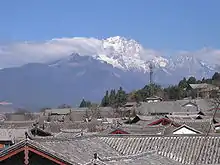
Jade Dragon Snow Mountain (玉龙雪山) is located between 100°4′2”-100°16’30” east longitude and 27°3’2”-27°18’57” north latitude. The scenic area is 415 square kilometers. The main peak fan is 5,596 meters above sea level. It has snow all year round and develops the temperate maritime glaciers closest to the equator in the Eurasian continent. Jade Dragon Snow Mountain is called "Oulu" in Naxi, meaning silvery mountain rock. Its silver-packed, 13 snow peaks are endless, just like a "dragon" flying over the clouds, it is called "Jade Dragon." Because its lithology is mainly limestone and basalt, it is black and white, so it is also called "black and white snow mountain". She is the mountain of the hearts of the Naxi people. It is said that the Naxi people protect the gods of the "three more" incarnation.[16]
The Laojun Mountain
The Laojun Mountain (老君山) is a combination of the three national-level scenic spots in the Jade Dragon Snow Mountain, the Three Rivers Concurrent, and the Cangshan Erhai Lake. It is an important part of the Yulong Snow Mountain Scenic Area. This scenic spot is mainly composed of Laojunshan Jiujiu Longtan, Jinsi Factory Jinshan Yuhu, Dawn Meile Danxia Landform, New Main Natural Alpine Botanical Garden and other areas (attractions), with a total area of 715 square kilometers, which is under planning and development. Ecotourism resort. It echoes with the Jade Dragon Snow Mountain and forms the east and west wings of Lijiang's tourism resources.[17]
Nearby
Some 35 kilometers north of Lijiang is the Baishui Terrace (白水台; bái shuǐ tái; 'White Water Terrace'), an area where spring water flows over a sinter terrace, leaving behind travertine.
Fifteen kilometers north of Lijiang is the village of Baisha, famous for the Baisha Fresco and the Naxi Hand-made Embroidery Institute. The Fresco was built in the Ming dynasty 600 years ago, the Naxi Hand-made Embroidery Institute was built 800 years ago, it is the headquarters of the Naxi embroideries and also, a school for the Naxi embroiderers. There are many Naxi embroidery masters, teachers, students and local farmers there. Their embroidery arts can be found there.
Education
Lijiang Teachers College (Chinese: 丽江师范高等专科学校; pinyin: Lìjiāng Shīfàn Gāoděng Zhuānkēxuéxiào) and Lijiang Culture and Tourism College (丽江文化旅游学院; Lìjiāng Wénhuà Lǚyóu Xuéyuàn) are located in Lijiang.[18][19] The latter was a branch of Yunnan University (YNU).[20] At one point the teacher's college merged into YNU.[21]
Sister cities
 Kazan, Tatarstan, Russia[22]
Kazan, Tatarstan, Russia[22] Roanoke, Virginia, United States
Roanoke, Virginia, United States.svg.png.webp) New Westminster, British Columbia, Canada
New Westminster, British Columbia, Canada Takayama, Gifu, Japan
Takayama, Gifu, Japan .svg.png.webp) Shepparton, Victoria, Australia
Shepparton, Victoria, Australia Whanganui, New Zealand
Whanganui, New Zealand Preah Vihear Province, Cambodia[23]
Preah Vihear Province, Cambodia[23]
See also
- Riding Alone for Thousands of Miles: a film by Zhang Yimou which takes place in the Lijiang area
- Resort town
References
- ↑ "China: Yúnnán (Prefectures, Cities, Districts and Counties) - Population Statistics, Charts and Map".
- ↑ "Old Town of Lijiang". UNESCO World Heritage Centre. United Nations, Educational, Scientific, and Cultural Organization. Retrieved 4 Apr 2021.
- ↑ Forbes, Andrew; Henley, David (2011). China's Ancient Tea Horse Road. Chiang Mai: Cognoscenti Books. ASIN: B005DQV7Q2
- 1 2 3 4 Kapstein, Matthew (2009). Buddhism between Tibet and China. Boston: Wisdom Publications.
- ↑ 学术动态—丽江木氏土司与滇川藏交角区域历史文化研讨会综述. iea.cass.cn. Archived from the original on February 15, 2017. Retrieved May 22, 2019.
- ↑ 丽江市人民政府门户网站. Lijiang People's Government. Retrieved May 22, 2019.
- ↑ 中国气象数据网 – WeatherBk Data (in Simplified Chinese). China Meteorological Administration. Retrieved 10 April 2023.
- ↑ 中国气象数据网 (in Simplified Chinese). China Meteorological Administration. Retrieved 10 April 2023.
- ↑ 丽江 - 气象数据 -中国天气网 (in Chinese). Weather China. Retrieved 26 November 2022.
- ↑ Yunnan Provincial Census Office, Yunnan Provincial Bureau of Statistics (September 2012). "Yunnan Provincial Census Data in 2010". China Statistics Press. ISBN 978-7-5037-6548-3.
- 1 2 3 4 5 丽江少数民族-云南省丽江市中级人民法院. ljzy.chinacourt.gov.cn. Retrieved May 22, 2019.
- 1 2 3 4 5 丽江不可错过的十大特色小吃_新浪旅游_新浪网. travel.sina.com.cn. Jul 13, 2017. Retrieved May 22, 2019.
- ↑ 沿途设5座车站、最高时速70公里...丽江有轨电车开建!. The Paper. 2019-10-31.
- ↑ 6月 我爱的丽江古城 每一个触目能及的地方都盛放着三角梅_旅游景点_丽江旅游_丽江网. www.lijiang.cn. Retrieved May 22, 2019.
- ↑ 泸沽湖啊,我想与你谈一场恋爱~_旅游景点_丽江旅游_丽江网. www.lijiang.cn. Retrieved May 22, 2019.
- ↑ 玉龙雪山. 52yulong.com.
- ↑ 世界自然遗产丽江老君山:重山叠岭气势恢宏_旅游景点_丽江旅游_丽江网. www.lijiang.cn. Retrieved May 22, 2019.
- ↑ "Home". Lijiang Teachers College. Retrieved 2022-04-22.
校址:云南省丽江市古城新团片区 邮编:674199
- ↑ "Home". Lijiang Culture and Tourism College. Retrieved 2022-04-22.
学院地址:云南省丽江市古城区玉泉路1号 邮编:674199
- ↑ "学院简介". Lijiang Culture and Tourism College. Retrieved 2022-04-22.
丽江文化旅游学院(原云南大学旅游文化学院)[...]
- ↑ "Historic Perspectives". Yunnan University. 2004-06-23. Archived from the original on 23 June 2004. Retrieved 2022-04-23.
- ↑ Successful use of heritage is the pledge of prosperous future of Euro-Asia Cities (DOC file). II International Conference of World Heritage Cities of Euro-Asia. Lijiang. 15–18 October 2006 Archived February 26, 2009, at the Wayback Machine
- ↑ 刘蓉 (2012-05-01). 丽江市与柬埔寨柏威夏省缔结为国际友好城市 [Lijiang establish international friendly city with Preah Vihear Province of Cambodia]. yndaily.yunnan.cn. Yunnan Daily Newspaper. Retrieved 2018-05-14.
External links
- Lijiang City Official website
 Lijiang travel guide from Wikivoyage
Lijiang travel guide from Wikivoyage- Lijiang Overview and Travel Guide

